Moo Shu Pork (木须肉, 木樨肉, 木犀肉) is one of those traditional Chinese cuisines which has been localized after ricocheted around the world.
When it starts to introduce to America, The American Chinese find that it is hard to get dried lily buds and wood ear fungus. As a result, they substituting them with cabbage, carrots, scallions and bean sprouts, and sherry instead of Chinese wine. It also becomes part of the filling of Chinese pancakes.
In this article, I try to stay close to the original recipe from the Shandong province. However, the essence of the dish will not change even if you can’t get wood ear fungus. It is primarily prepared by stir-frying meat slices, mixed vegetables, and eggs.
What is Moo Shu Pork?
This shredded egg pieces in this cuisine resemble the Osmanthus 桂花, and hence how it gets the name. Moo Shu Pork is originated from Shandong, which is prepared with eggs, pork, wood ear fungus, and also included bamboo shoots. When it starts to get populated at Beijing, chefs find that it is hard to get bamboo shoots, and therefore begins to substitute it with dried lily flowers and cucumbers.
Note: This post may contain affiliate links. Please read my privacy policy for more info. I may receive commissions for purchases made through links in this post.
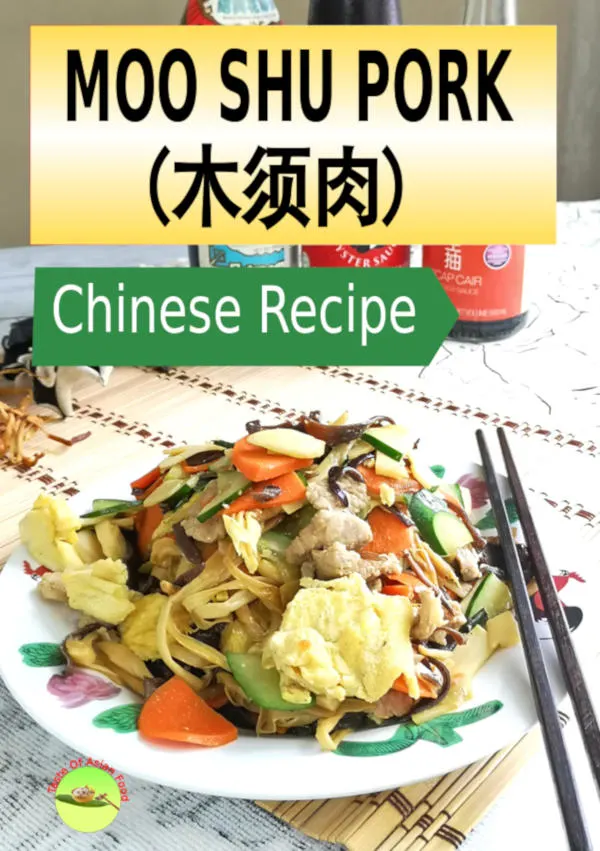
How to prepare Moo Shu Pork- A step by step guide
1. Marinate the pork
I prefer to use pork loin with a little bit of fat for this recipe. It is smoother compared to lean pork and more tender than pork belly. You may substitute the pork with chicken breast meat to make Moo Shu Chicken. I have made that before which turned out as good as by using pork.
Cut the pork into thin slices, and combine the pork with some cornstarch, egg white, and light soy sauce. Cornstarch and egg white help to smoothen the texture, and soy sauce add additional umani to the pork. Marinate for fifteen minutes should be sufficient as the pork is already cut into thin slices.
How much oil is required to stir-fry the pork?
We usually fry the pork with lots of oil in the restaurant and then pour it into a strainer to remove the excess oil. This method has two advantages:
- Since the pork slices are evenly cooked in the oil.
- The pork slices will not stick to the bottom of the wok due to the excess of oil.
If you do not want to use this method because it consumes too much oil, pan-fry the pork over low heat, either omit the cornstarch or use a non-stick pan to avoid the pork slices from sticking.
If you use the restaurant method, be generous with the amount of oil as the remaining can be used to stir-fry the vegetables and making the omelet.
Here are the steps to be taken
- Add the oil into the wok.
- Add the ginger slices, garlic, and scallion. Stir-fry briefly for about fifteen seconds and then add the pork.
- Stir fry the pork until the color has changed Remove the pork.
- Leave the remaining oil in the wok to fry the egg.
2. Make the omelet
Beat two eggs in a bowl and mix with a pinch of salt, a teaspoon of cornstarch and a tablespoon of wine. The cornstarch would mix with the wine to form a slurry before adding to the egg to avoid forming lumps. You can use water instead of wine, but wine gives a better flavor.
Fry the egg with the remaining from frying the pork as it is very flavorful. Add some extra oil if necessary. This oil has a flavor of pork, scallion, garlic, and ginger. Swirl the egg in the wok to form an open omelet. Cut the egg into large pieces with the wok spatula. Set aside.
3. Prepare the vegetables
Cut the carrot and cucumber into thin slices or fine julienne. I have seen both presentations in different restaurants. It is your personal preference, which will not affect the flavor.
Soak the wood ear fungus and dried lily buds until they are fully hydrated, which takes an hour or two. You can soak it even overnight to ensure that they are well hydrated. If this is the first time you encounter these items, I can assure you that they will not have any problem to soak it for even the whole day!
Remove the stem of the wood ear fungus, and cut it into smaller pieces.
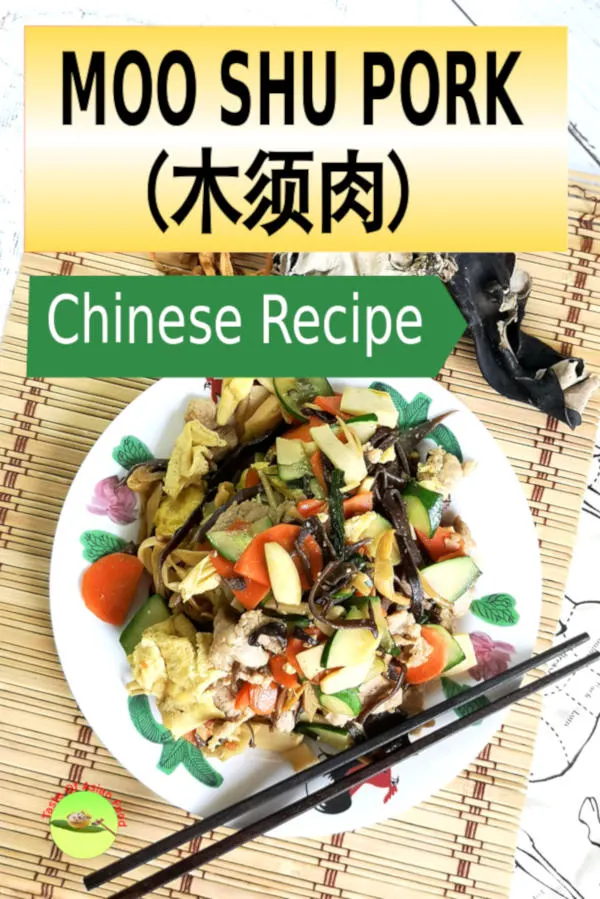
4. A quick five minutes stir-frying
Now let me break down the stir-frying steps in detail.
Stir fry the carrots in the wok with the remaining oil after making the omelet. Add some water if necessary.
Start with cooking the carrot since it takes a longer time to turn soft. I usually add some water little by little into the wok to cook the carrot after half a minute of quick stirring. After that, add the bamboo shoots, soaked wood ear fungus and dried lily buds.
You do not need more oil at this point. Add one or two tablespoons of water from time to time if it becomes too dry. There is already sufficient oil in the pork and omelet.
Add the seasoning (oyster sauce, light soy sauce, dark soy sauce, sugar, ground white pepper) to the vegetables in the wok. You can omit the dark soy sauce if you want the vegetables to look brighter. Add the cucumber and egg pieces and mix well.
Now it has come to the final part of cooking. Turn up the heat and give it a few quick stirs and flips, to reduce the liquid if it is too wet. Turn off the heat. Add some sesame oil and wine. Mix well and serve.
Some chefs would prefer to add some cornstarch slurry to thicken the sauce at the end of cooking. I prefer to leave it out but make it less watery instead.
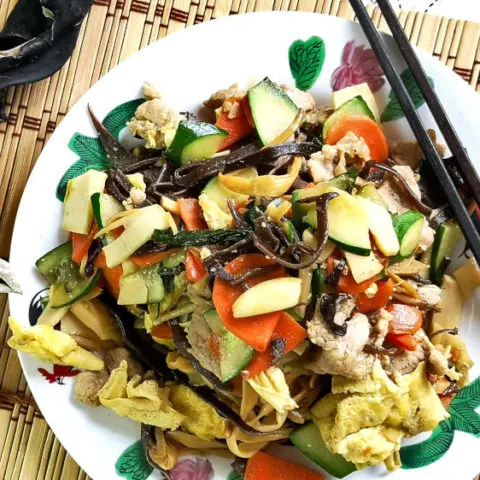
Moo Shu Pork (木须肉)
Moo Shu Pork (木须肉) is a traditional Northern Chinese cuisine prepared by stir-frying meat slices, mixed vegetables, and eggs. It is easy to cook, to be served with rice or even as the filing of pancakes.
Ingredients
(A) Marinate the pork
- 200g pork
- 1/4 tsp salt
- 1/4 egg white
- 1 tbsp Chinese wine (or sherry)
- 1 tsp cornstarch
(B) The egg
- 2 eggs
- Pinch of salt
- 1tsp of wine
- 1/2 teaspoon of cornstarch
(C) The vegetables
- 15g wood ear fungus (dry weight)
- 15g dried lily buds (dry weight)
- 60g bamboo shoot
- 100g cucumber
- 80g carrot
(D) Seasonings
- 2tsp oyster sauce
- 2tsp light soy sauce
- 1/4tsp dark soy sauce (optional)
- 1tsp sugar
- 1/4tsp ground white pepper
- (E) Others
- 5 ginger slices
- 1 stalk of scallion
- 3 cloves garlic
- 1tsp sesame oil
Instructions
- Cut the pork into thin slices.
- Marinate the pork with the ingredient in (A) for fifteen minutes or more.
- Stir-fry the ginger slices and scallion with some oil. Add the pork and stir-fry until it is just changing the color and cooked.
- Beaten two eggs in a bowl and mix with a pinch of salt, a teaspoon of cornstarch and a teaspoon of wine.
- Fry the egg like making an open omelet. Cut the egg into small pieces.
- Cut the carrot and cucumber into thin slices.
- Soak the wood ear fungus and dried lily buds until they are adequately hydrated. Remove the stem of the wood ear fungus, and cut it into smaller pieces if it is too big.
- Stir fry the carrots in the wok. Add some water if necessary. When the carrot slices turn soft, add the bamboo shoots, soaked wood ear fungus and dried lily buds.
- Season with the ingredients in (D). Add the cucumber and egg pieces and give it a few quick stirs and flips.
- Add some sesame oil and wine. Mix well and serve.
Notes
If you encounter any audio / visual problem of viewing this video, you can view it from YouTube by clicking this link, which will open in a new tab.
Recommended Products
As an Amazon Associate and member of other affiliate programs, I earn from qualifying purchases.
-
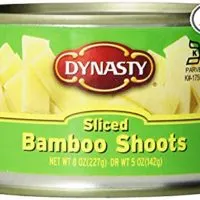 Dynasty Canned Sliced Bamboo Shoots, 8-Ounce (Pack of 12)
Dynasty Canned Sliced Bamboo Shoots, 8-Ounce (Pack of 12) -
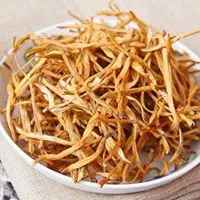 Tomox 200g Dried lily flower day-lily buds Chinese specialty quanlity 黄花菜
Tomox 200g Dried lily flower day-lily buds Chinese specialty quanlity 黄花菜 -
 Joyce Chen 21-9972, Classic Series Carbon Steel Wok Set, 4-Piece, 14-Inch Charcoal
Joyce Chen 21-9972, Classic Series Carbon Steel Wok Set, 4-Piece, 14-Inch Charcoal -
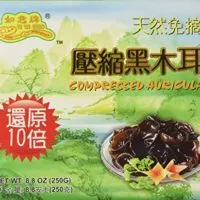 Premium Dried All Natural Compressed Chinese Auricularia Black Fungus Mushroom (Black Wood Ear Mushroom) - 8.8 Oz -- 10 Times Volume Yield After Soaking
Premium Dried All Natural Compressed Chinese Auricularia Black Fungus Mushroom (Black Wood Ear Mushroom) - 8.8 Oz -- 10 Times Volume Yield After Soaking
Nutrition Information:
Yield: 2 Serving Size: 2 servingsAmount Per Serving: Calories: 422Total Fat: 21gSaturated Fat: 7gTrans Fat: 0gUnsaturated Fat: 12gCholesterol: 274mgSodium: 1085mgCarbohydrates: 16gFiber: 2gSugar: 6gProtein: 35g
This data was provided and calculated by Nutritionix on 5/7/2019


Mike
Wednesday 8th of May 2019
Can I substitute chicken and use the recipe
KP Kwan
Wednesday 8th of May 2019
Hi Mike, Absolutely. I used chicken breast meat before which turned out very well too. KP Kwan
KP Kwan
Wednesday 8th of May 2019
Hi, this is KP Kwan. I am happy to see you in this comment area, as you have read through my recipe. I am happy to reply to any questions and comments as soon as possible.